Use a knowledge sharing tool (that does more) to create your Employee Handbook
Whether you're a big enterprise or a small business, you have policies and procedures for your workplace. You created them because you knew it was essential that your colleagues were on the same page as your company’s mission statement, ethics, and future expectations. By taking the steps in creating guidelines and protocols, you began taking the critical action of running an efficient and effective company.
Employee Handbook template
If you like what you see just below, you can start your workspace with it now.
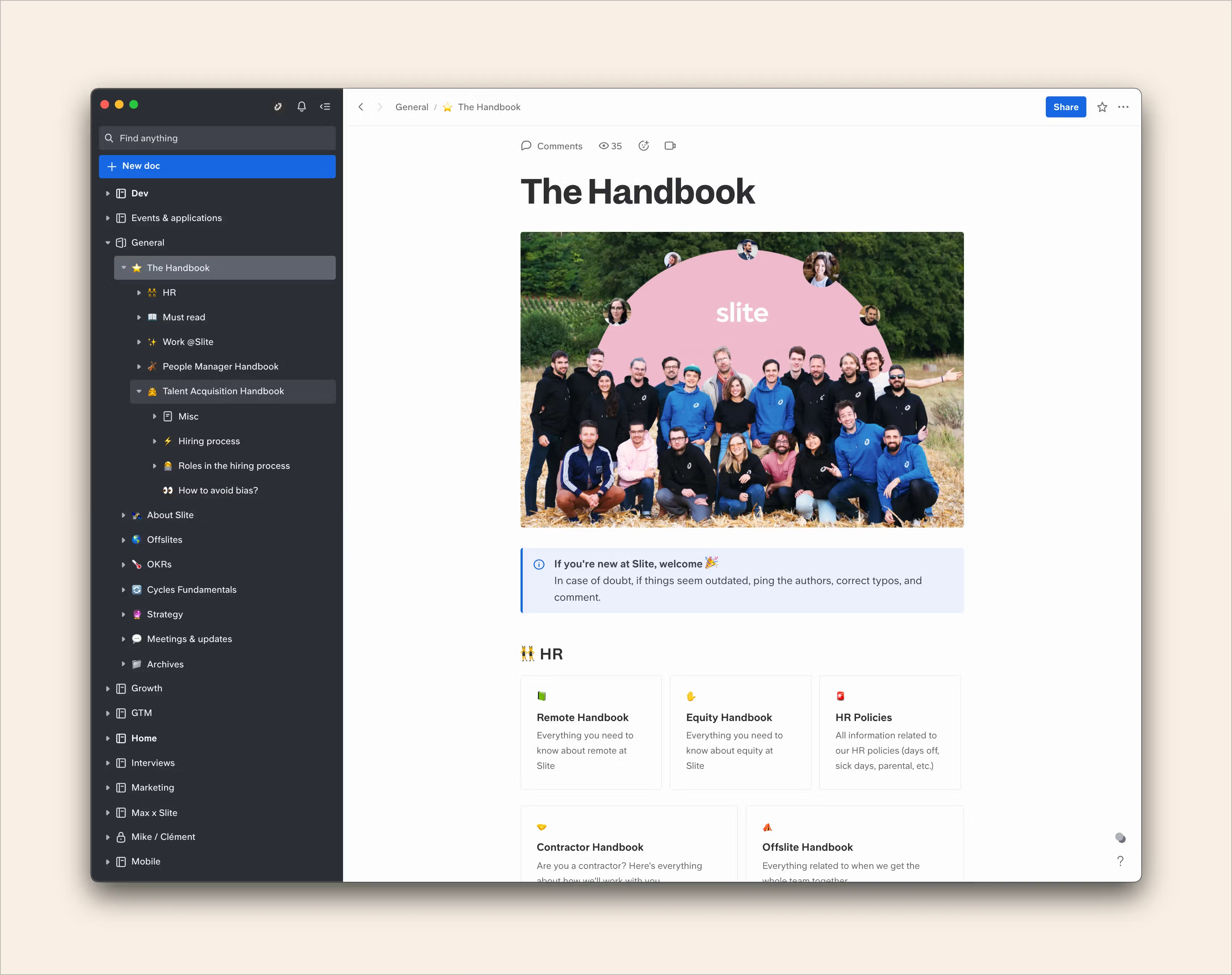
How to build your Employee Handbook, step-by-step
1. Think about the big picture
What are the most important things that new hires and company employees should know about their work environment? What core values and ideals do you want to make absolutely clear to them?
2. Put together a table of contents
This will help you outline all the main points you want to cover and make writing a great employee handbook that much easier. Bring as many information as possible, put please keep a decent reading experience! You can generate one automatically in Slite.
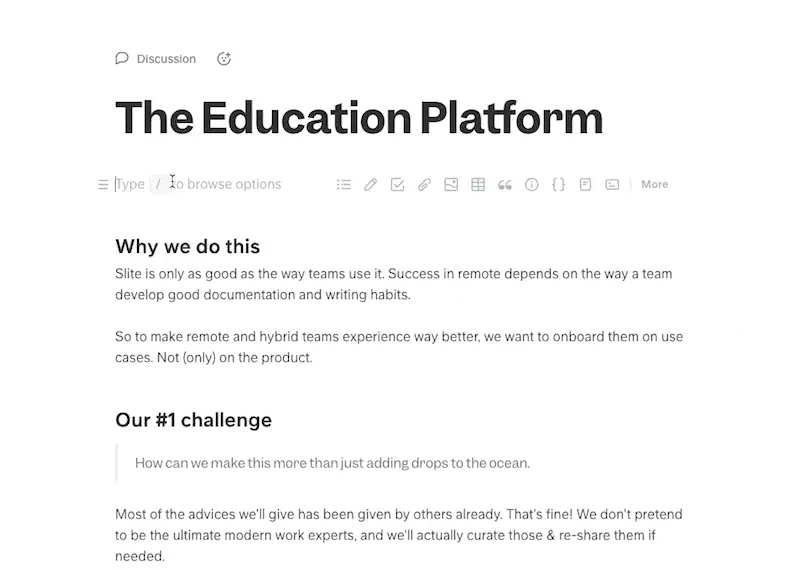
3. Establish essential company information
Make sure you cover the basics: your company's mission, background & history, core values and company policies, general tools & tips, and human resources information.
4. Make An Outline
Note down the policies that will be most important and relevant to your new hires and company employees. Make sure to cover things like: the code of conduct, anti-harassment, non-discrimination & equal opportunity employment policies, workers' compensation & applicable federal laws, employee benefits (perks, health insurance, PTO & vacation policies), work hours, sick leave policies, substance abuse policies, jury duty policies, social media guidelines, and dress code.
5. Include Management Resources
This is great for setting clear expectations and precedents for different management situations; vital to any healthy employment relationship.
Include additional templates relating to performance reviews, personnel files, meetings, and roles & outcomes.
6. Cover Hiring Resources
This section will be vital to new employees and help answer some of their immediate questions! Include information about the onboarding process, employment contract information, human resources, company culture, job description, and evaluation criteria. Voila! Just like that, you'll be well on your way to putting together the perfect employee handbook.
What is an employee handbook?
An employee handbook helps bring together all of your outlined goals, benefits, and procedures into one convenient source so that your corporate culture takes shape in a more formally. This not only protects your organization’s best interests but helps ensure against breaking any required state or federal laws.
As briefly stated above, an employee handbook or manual defines the key policies and procedures of a company, as well as outlines the cultural expectations. This helps bring the mission and values into sharp focus for current and future employees who may get hired on later. By using this type of document as an introduction to your workplace, new team members will have an easier time understanding how your environment works and what they should expect to do in their job roles: from human resources, to how to take time off, to medical leaves and more.
Employees can also rely on this to learn how their behavior and performances will affect their working relationship with your business. Having clearly stated protocols regarding topics such as sexual harassment or fraternizing with other employees will educate employees and their supervisors on what is or is not acceptable. This helps to avoid disputes in the future if issues arise from these challenging situations.
The importance of an effective Employee Handbook
Having a standardization of benefit policies and personnel expectations is probably the top reason any company with more than one employee should have an employee handbook. It helps avoid confusion and gives your team a path to follow if there were ever a disagreement or complaint that required upper management to get involved. It also ensures equal employment opportunities.
While these are excellent demonstrations of why we should invest our time in creating these resourceful manuals, there are several important reasons to have handbooks.
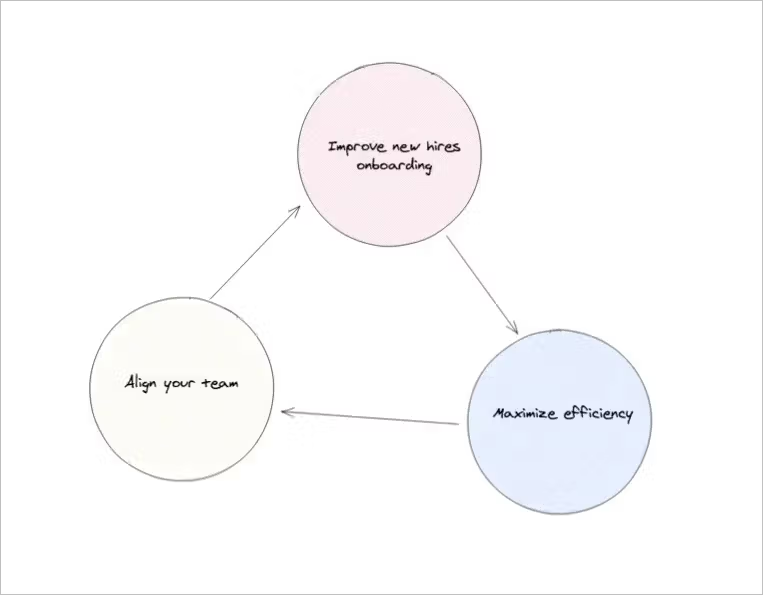
Formalizing company policies brings clarity
Sometimes companies create policies that are not formal and often change depending on who handles a situation or how an informal practice gets interpreted. This causes confusion, the risk for a lawsuit, and inconsistent information gets treated like a standard. Writing an employee handbook forces you to define the employee policies that affect your work environment and business success all in one location.
Create uniformity within your company
The old saying about “having everybody on the same page” rings so true when you are an employer and business owner. Your employee handbook needs to promote the idea that the rules get applied equally within your corporation so that your employees understand that these are the rules to play by if they want to succeed.
Employee Handbooks spares everyone time
Imagine an employee handbook that provides crystal clear answers to frequently asked questions about your company’s work culture and benefits. The time saved by not having to answer the same inquiries, and your employees’ saved time by having the opportunity to look up answers on their own is a huge plus!
Prevents legal disputes
Having the terms and conditions of your employment relationship and complete guide to company policy serves as effective legal protection for your business.
Onboarding is speedier and straightforward
New employees find these handbooks invaluable when learning the ropes and catch up to speed. It’s also a great reference tool for senior staffers, as well. Your team can take more time at making your new employees feel home and comfortable with their job.
You communicate about company culture
Whether your company takes a casual approach to office life or has a strict adherence to professionalism, an employee handbook will clearly communicate how this balances with your values and mission, and what the employee benefits are. This especially makes sense in a remote context.
It demonstrates compliance
Federal, state, and even local district regulations may have specific rules and protocols your company must follow. Having your guidelines laid out so that everyone knows and follows these important duties demonstrates your compliance.
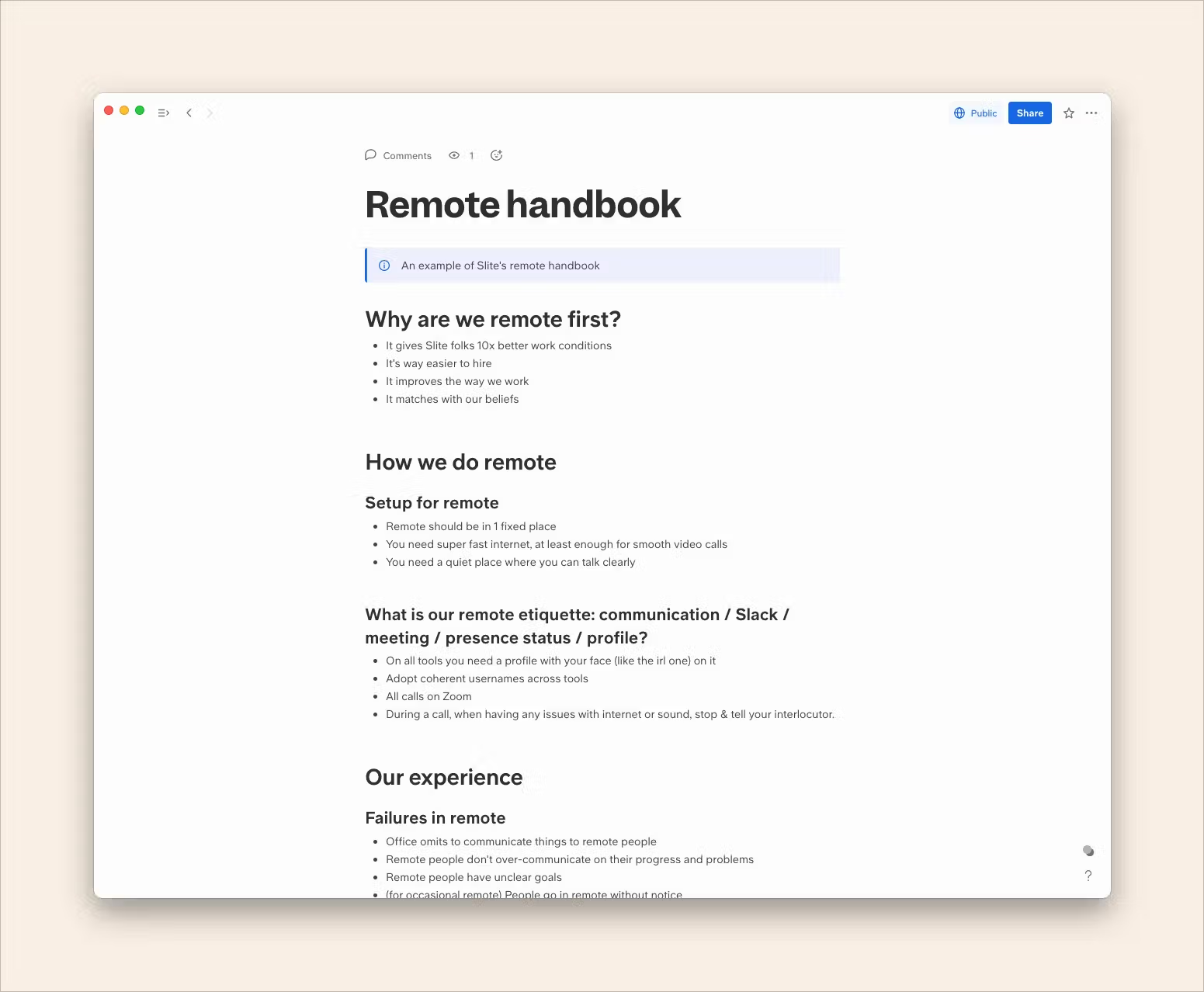
Who Creates the Employee Handbook?
Generally, most organizations rely on their Human Resources (HR) team to handle the creation of these manuals. The reason for this has to do with the specialized training, in-depth knowledge, and legal knowledge HR professionals possess. This helps them to contextualize policy and procedures while taking note of any legal ramifications that may result if one of those elements does not get appropriately communicated.
Sometimes smaller startups don’t have an HR team on hand and rely on their leadership to create an employee handbook instead. This leader may trust their marketing department head to word text as understandably as possible.
Finally, others have pursued a collaboration between management and employees by writing up a rough draft and asking team members to review it. Team handbook building is a growing trend in many companies trying to foster an open team environment within their companies.
What Elements are in an Employee Handbook?
Employee handbooks cover a broad range of topics, so there are numerous elements to consider before you even begin to create it. All of these different sections can fall under larger categories to help you organize your manual correctly.
Your employee manual should include these main categories, which will form the pillars of your specific workplace policy and protocols to give team members a foundation of understanding:
- Terms of Employment
- Workplace Protocols and Procedure
- Code of Conduct
- Compensation and employee benefits
- Benefits and Development Opportunities
- Work Scheduling, PTO, medical leave and Vacation Policies
- Resignation and Termination of Employment
While this is not a definitive list due to variances in federal, state, and local laws, these give you a beginning outline for adding specialized sections under the appropriate category. You can get started with this free template:
What Sections Do You Need in Your Employee Handbook?
To craft that perfect employee manual, you will need to identify what sections you need under the main categories mentioned earlier. Many companies choose based on what information will maintain employees’ satisfaction and policy knowledge while also aiding the pursuit of business objectives. This approach demonstrates how handbooks and their success depends on how you write policies and how much you share about them.
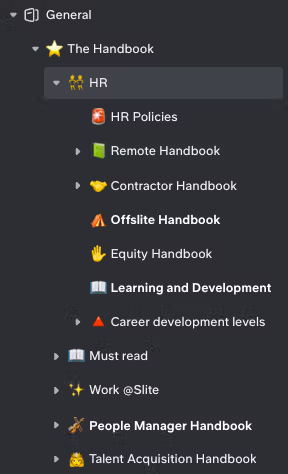
Terms of Employment
This is typically the first section that employees will read when they receive their manual because it has the most information about their job role. Some may consider this an FAQ section as it answers some of the most basic of questions about their contract and job classification.
Attendance
A clear outline of attendance policy so employees know what to do if they cannot make it to work, the kind of notice required, and what qualifies as an excused or unexcused absence.
Employee classification
Many companies have a mix of both exempt and nonexempt employees that receive different levels of privileges and benefits. It’s essential to define what these classifications mean and how they are different. This section should also include the definitions and differences of full-time vs. part-time employees.
Workplace Policies (we don't have any at Slite)
Under this section, many companies will have some similarities and differences because of business or employee demands. Because this part of your employee handbook will act as a guide to what your workplace environment is like, focus on the conditions they must work within as a member of your team.
Confidentiality and data protection
As a corporation, your employees will have access to not just customer information, but protected product or service data. Having a policy outlining how, when, and what workers can do with this information is critical to the integrity of your products and consumer relationships.
Workplace harassment and violence policies
In order to create a safe and collaborative workspace, creating policies that define company policy regarding the harassment of others and any violence is a must. You will need to specify what harassment is and list out potential consequences.
On the job safety and health
You should include not just your own protocols for workplace health and safety but also include any law-related rules. Include the steps your company will take whenever an accident or safety incident occurs along with where training materials are available if your employees want more information.
Code of conduct
Separate from harassment and violence prohibitions, your code of conduct chapter is a vital framework of company behavior expectations and creating an anti-harassment environment. Take the time to evaluate the requirements you have of your staff, and how it will affect your business and operations. You should cover the treatment of other coworkers or guests alike on matters of security to impressions left on consumers.
Dress code
Whether your dress code is casual or professional, you should put it in writing. One’s style is subjective, so letting teammates know what they should or should not wear is very important and will avoid any embarrassing situations.
Internet security and related devices
In this modern age of technology, internet access, cell phones, social media, and email or mandatory tools that our teams need to do their jobs. Still, this tech has ingrained itself into our lives so much we tend to lose sight of company time or behavior policies. Outline your Internet and digital device policy clearly, but keep in mind that technology is second nature for many of us now.
Conflicts of interest
Depending on your business, a conflict of interest could pose a serious legal situation if an employee breaks established rules or laws regarding these situations. If appropriate, describe what a conflict of interest is and what actions to take so no violations occur.
Workplace relationships
This again depends on the type of company you have and how much control you feel is necessary to avoid toxic workplace environments and conflicts of interest. Whether it is a close friendship or employees start dating, it is vital to clearly outline what level of fraternizing between coworkers is permitted. It makes sure your company stays in accordance with employment laws.
Nepotism
When hiring or promoting family members, it isn’t uncommon for accusations of favoritism to float around. Use this section to dictate what working relationships can or cannot exist in your organization between related employees.
Company guests
You should always include a guest policy to protect your business against accident claims and data breaches while someone visits your property. Having a stated procedure and policy about visitors will keep employees aware of and accountable for these guests.
Solicitation
We all have had encounters with Girl and Boy Scout parents who want to raise money for their troops by selling cookies. These situations could cause a conflict of interest or an annoyance to those feeling pressured to buy. Make a clear policy about soliciting or distributing products that are not related to company business.
Compensation and Development Opportunities
Employees rely on this section heavily to understand how the payroll process works and what possible future opportunities they may have for growth within your company. It’s crucial to emphasize policies that enhance your employees' value and offer motivation to remain with your company.
Types of compensation
This section can go into the types of payroll your organization utilizes and what employment status receives it. You can also further explain the handling of overtime hours and what the laws are surrounding those kinds of hours.
Performance Reviews
Here you can connect an employee’s performance to future opportunities within the company, as well as inform managers of their role in this process.
Training and development
Retention is an essential feature of your company’s success because the constant orientation of new hires is a costly process. Use this section as a place to show ways in which your employees can improve their job performance and personal self.
Employee benefits and perks
Very often, employees only learn about some of the benefits and perks their employer offers by word of mouth or a mass-distributed email. This means your investment in these extras gets under-used, and that creates a waste of money and motivation. Use this category for more than just the usual legal documentation surrounding workers' compensation by including information about things like a gym discount you offer.
Employee health benefits
This section should include everything from an overview of health insurance offerings to any wellness or special health programs you may offer. You should also include your FMLA (Family and Medical Leave Act) and COBRA policies here too.
Workers’ compensation
If an employee gets injured on the job, they will rely on this section of your employee handbook heavily. They need to know the process and what benefits they get in their employment contract, along with any other resource information you deem appropriate for that situation.
Remote policies
Remote is a growing popular method of working because of the savings in corporate costs and flexibility options that allows you to competitively hire quality team members. Outlining how an employee could apply for this option, or what job roles may receive consideration is helpful here. Stating the requirements and rules for remote work is also necessary so that proper security measures and conduct are clear.
Expense reporting
A straightforward policy and procedure section regarding work-related expenses are invaluable for your company’s bottom line. Include covered charges within your employee handbook to avoid disputes.
Company car
For employees who get a company car benefit, take time to craft guidelines that cover what expenses your organization will pay, what to do if there is an accident, and information for service if the vehicle experiences mechanical issues.
Parking
Some companies do not have a dedicated parking lot, and the staff has to pay, or you provide a parking pass. Either way, make sure to detail the application process for getting parking costs reimbursed or a permit issued in this section. This should also include dates when parking fees get paid or passes released.
Company Equipment
When you issue phones, laptops, printers, or other equipment to your team, emphasize the importance of these items and how to care for them. These are valuable assets of your company, and you want your staff to treat it all as such. Include what to do if anything is lost, stolen, or damaged along with any liability on the part of the employee for this occurring.
Vacation time and PTO
Another popular category employees often use as a reference when making time-off requests, It’s important to detail procedure and policy on how this time may be used. Employees rely on this information to plan their vacation time with their family or to pursue other hobbies and interests, so use clear language that is easy to understand.
Work hours and paid time off
Here you can outline what time you expect employees to arrive and when to leave the workplace. You can mention any exceptions in regard to weather or other unforeseen circumstances. Also, cover how many days of paid time off and what conditions qualify them for those periods. Don’t forget to detail how to apply too!
Holidays
Use a list with all the holidays your business observes and how employees get compensated are necessary here.
Sick leave
Define what qualifies as sick leave according to the law and company guidelines. Include any additional illness benefits that may involve short and long-term health problems.
Bereavement
The unpredictable nature of life usually requires that employers give their workers at least a couple of days bereavement leave. This type of policy goes a long way in building a compassionate relationship with your employees.
Elections and jury duty
Many states have specific laws and rights surrounding election events and jury duty obligations. Outline what those laws and rights are for these duties and any documentation you may require to excuse their absence as a result.
Parental leave
Depending on the state where you live, paternity and maternity leave may have legal guidelines you must follow. If this is not the case, you should still consider a policy like this to accommodate your employees and their families during such a joyous time in their lives.
Employee resignation and termination
Sometimes a job just isn’t a good fit, or things change, and a better opportunity is elsewhere. Whatever the reason or situation, offboarding needs a section unto itself. This section should cover everything from disciplinary procedures, last paycheck dates, and even exit interview procedures so that nothing is left to question.
Disciplinary action
This section is crucial for your managers just as much as it is for the employees they manage. Make sure your discipline process has an explained step-by-step approach and what role managers play in documenting the situation. It's crucial to ensure workplace safety and anti-discrimination
Resignations
Set out your expectations for what notice your company expects in cases where an employee resigns their position. You can also talk about employment lengths and tuition or relocation costs that may have been granted contingent on employment length.
Termination of employment
Take the time to carefully discuss any applicable federal or state laws around the decision to terminate one’s employment, as well as defining your own internal termination process. If any worker statuses enjoy severance pay, or if employees may have any unused vacation or sick time, make sure to outline how those situations get compensated. If you have a reference policy, you can add a quick comment in this section, as well.
Close your Employee Handbook positively
Once you have the main contents of your handbook complete, make sure to write a quick overview of the purpose of the book, a point of contact for any questions, a reminder that policies may change, and an acknowledgment signature line. Make sure you emphasize how excited you are to have them on board with your organization and that you are looking forward to working with them.
Use a knowledge sharing tool (that does more) to create an Employee Handbook
Grab your Employee Handbook template
At the end of the day, your employee handbook cannot read in generalizations or broad-brush policies. Specifications and detailed reference are critical to creating a guide that answers questions instead of creating more. Your manual should support any applicable laws and have clear compliance processes outlined.
The best of handbooks won’t succeed if team members cannot access it easily or you cannot verify if every employee has read and understood what is in it. With these points in mind, you may consider working with Slite to create an up-to-date and legally compliant employee handbook that covers everything your employees need to know about your company, its vision, and the policies that make it successful.
With Slite, you can utilize our knowledge management tool to create a collaborative approach that creates a tailored employee handbook that fulfills its purpose: bringing knowledge for all into one organized location for ease of access and understanding. Visit today to get a sneak peek at all the tools we have to offer to craft the perfect employee handbook your company can rely on to succeed.

